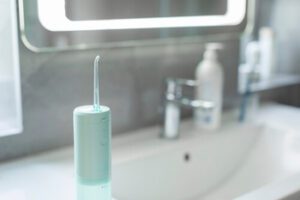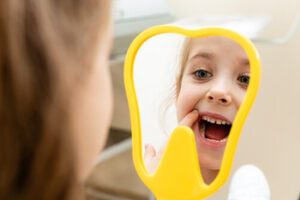You’ve probably heard of fluoride in conversations about toothpaste, tap water, or your child’s regular dental check-up. But have you ever stopped to ask, “What does fluoride do, exactly?” More importantly, why is it a key part of kids’ dentistry and overall dental care?
Let’s unpack the science, myths, and practical takeaways about fluoride, especially its vital role in preventing tooth decay, building strong teeth, and promoting lifelong oral health.
Fluoride 101: The Basics of This Natural Mineral
Fluoride is a naturally occurring mineral found in soil, rocks, water, and even the air we breathe. It’s also present in various everyday sources, including certain foods, such as breast milk and drinking water. You’ll often find it added to dental care products like toothpaste and mouth rinses—but what makes it so important?
The answer lies in its protective role. Fluoride helps strengthen tooth enamel, the hard outer layer of your teeth, making it more resistant to damage caused by acids from plaque and sugary foods—two of the main culprits behind dental decay.
So, What Does Fluoride Do For Our Teeth?
Think of fluoride as your teeth’s personal bodyguard. It works around the clock to keep your enamel strong and your smile healthy. Here’s how it does that:
Strengthens Tooth Enamel
Fluoride helps remineralise enamel (the tough outer layer of your teeth) by replacing lost minerals caused by acids from food and plaque. This makes enamel more resistant to future acid attacks and wear.
Fights Off Harmful Bacteria
Fluoride interferes with the ability of cavity-causing bacteria to produce acid, reducing the overall acidity in your mouth and slowing down the decay process.
Reverses Early Tooth Decay
Caught early enough, fluoride can actually stop and reverse the early stages of tooth decay. It rebuilds weakened enamel before a full-blown cavity forms
Protects Developing Teeth in Children
Fluoride is especially important for kids because it becomes part of their growing permanent teeth. This built-in protection helps prevent cavities before their adult teeth even erupt.
 Works Systemically and Topically
Works Systemically and Topically
Whether you’re drinking fluoridated tap water or using fluoride toothpaste, the mineral protects your teeth both from the inside (systemically, through water or supplements) and outside (topically, through brushing or rinses).
In a nutshell, fluoride prevents tooth decay, strengthens enamel, and supports long-term oral health. Whether you’re a toddler just learning to brush or an adult protecting your smile, fluoride plays a crucial role in your dental routine.
Why Fluoride Is a Cornerstone in Kids Dentistry
When caring for children’s teeth, fluoride is an absolute game-changer and for good reason. Kids are at a greater risk of tooth decay because their enamel is still developing, their brushing skills aren’t perfect yet, and sugary snacks are often part of the picture. That’s where fluoride steps in as a silent hero.
Protecting Baby Teeth and Guiding Permanent Ones
Even though baby teeth are temporary, they play a key role in speech, chewing, and holding space for permanent teeth. Fluoride helps keep these little teeth strong until they’re ready to naturally fall out and make way for adult ones.
For permanent teeth, fluoride becomes part of their structure as they form under the gums, making them stronger even before they erupt.
Fluoride Treatments at the Dentist
At your child’s routine dental visit, your dentist may recommend a professional fluoride treatment, especially if your child is prone to cavities or has early tooth decay. This might be in the form of a gel, foam, or varnish placed directly on the teeth in a quick and easy procedure.
These in-chair treatments deliver a high fluoride concentration to the enamel, helping to prevent tooth decay more effectively than toothpaste alone, particularly for kids with orthodontic brackets or a history of cavities.
Drinking Fluoridated Tap Water Makes a Difference
One of the easiest ways kids get a regular fluoride dose is by drinking fluoridated tap water. It’s a simple, passive way to support their oral health, and it’s been shown to significantly lower the risk of cavities in children.
If your local tap water isn’t fluoridated or your child drinks mainly bottled or filtered water, your dentist may recommend fluoride supplements to make up for the difference.
Safe Use with the Right Amount
Using fluoride toothpaste from an early age is essential, but supervision is key. Kids under six should use a pea-sized amount (or a smear for those under three) to avoid swallowing it. This helps prevent dental fluorosis, a cosmetic condition caused by ingesting too much fluoride while teeth are developing.
In short, fluoride in kids dentistry isn’t just helpful; it’s essential. It sets the foundation for a lifetime of healthier, stronger teeth by preventing dental caries before they even begin. Whether through fluoride treatments, fluoridated drinking water, or fluoride toothpaste, this natural mineral plays a starring role in your child’s smile journey.
Fluoride Toothpaste: Small Amount, Big Impact
Fluoride toothpaste is one of the simplest and most effective ways to prevent tooth decay when brushing teeth. But how much fluoride should you use for your child?
- Under 3 years of age: A smear or rice grain-sized amount of low-fluoride toothpaste
- 3 to 6 years: A pea-sized amount of standard fluoride toothpaste
Supervising your child while brushing is important to ensure they spit, not swallow. While trace amounts of fluoride are safe and beneficial, swallowing large amounts regularly could lead to issues like dental fluorosis (more on that shortly).
What Is Dental Fluorosis, and Should You Be Concerned?
If you’re a parent, you’ve probably encountered the term dental fluorosis while learning about fluoride toothpaste or fluoride treatments for your child. And, like many, you might be wondering, is it something to worry about?
Let’s clear up the confusion.
What Exactly Is Dental Fluorosis?
Dental fluorosis is a cosmetic condition that occurs when a child consumes too much fluoride while their teeth are still developing, typically before the age of eight. It doesn’t affect the health or function of the teeth but may change how they look.
The most common signs are:
- Faint white streaks or spots on the teeth
- In rare cases, mild discolouration or pitting in more severe forms
It’s important to know that mild dental fluorosis is very common and usually barely noticeable often only detectable by a dentist during an examination.
What Causes It?
Fluorosis happens when there’s excess fluoride in the system during tooth development. Common causes include:
- Swallowing too much fluoride toothpaste
- Taking fluoride supplements unnecessarily
- Consuming fluoridated water and other sources of fluoride at high levels simultaneously
This is why proper supervision and guidance are crucial when introducing fluoride to your child’s dental routine.
How to Prevent Dental Fluorosis in Children
Preventing fluorosis is all about balance. Here’s how you can keep things in check:
- Use a low-fluoride toothpaste for children under 6
- Stick to a pea-sized amount for kids aged 3–6, and a smear for toddlers under 3
- Teach children to spit, not swallow toothpaste.
- Avoid giving fluoride supplements unless recommended by your dentist.
- Know the fluoride levels in your drinking water, especially if you’re using dietary supplements or live in a high-fluoride area.
Should You Be Concerned?
In most cases, no. Mild fluorosis is harmless and often fades with time or is barely visible. In fact, many parents never even notice it. And remember, fluoride’s benefits far outweigh the risks, especially when used correctly.
If you’re ever unsure, your dental professional can assess your child’s risk and recommend the best approach for maintaining strong, healthy teeth without overdoing it.
So, should you be concerned? Not really, but staying informed helps you use fluoride wisely and effectively, especially during those early years when your child’s baby teeth and permanent teeth are taking shape.
Fluoride Treatments at the Dentist’s Office
A professional fluoride treatment is a safe and effective way to give your child’s teeth a protective boost. The treatment, often done during a routine check-up, involves applying a high-strength fluoride gel or varnish to the teeth.
These treatments:
- Strengthen enamel more effectively than at-home products.
- Help repair areas of early tooth decay.
- Offer targeted protection, especially for kids with orthodontic brackets, which can trap food and plaque.
Your dental professional may recommend fluoride treatments every 6 or 12 months, depending on your child’s needs and oral health history.
Fluoridated Tap Water: Why It’s a Win for Public Health

In Australia, fluoridated water has been shown to reduce tooth decay by up to 26–44% in children and adults alike. The practice is supported by organisations such as the Australian Dental Association, the Medical Research Council, and the Centers for Disease Control and Prevention (CDC).
When your family drinks fluoridated tap water, you’re protecting teeth without even thinking about it.
But Isn’t There Fluoride in Our Diet Already?
Yes, fluoride occurs naturally in the environment and is found in:
- Certain medications
- Dietary supplements
- Many foods (especially seafood, tea, and gelatin)
- Drinking water, even without added fluoride
However, the fluoride concentration in these sources varies and often isn’t high enough to offer protective benefits. That’s why adding fluoride to toothpaste, tap water, and fluoride mouth rinses is still necessary.
How Much Fluoride Is Safe?
Let’s get this clear: too much fluoride over a long period can lead to skeletal fluorosis; a rare condition that affects bones and joints, but this only occurs in areas with naturally high fluoride levels in the groundwater, not in regulated systems like those in Australia.
The Dietary Reference Intakes (DRIs) and public health bodies recommend the following fluoride levels for safety and effectiveness:
- For children aged 1–3: 0.7 mg/day
- For children aged 4–8: 1.0 mg/day
- For adults: 3–4 mg/day
These amounts are generally met through a mix of fluoride toothpaste, fluoridated drinking water, and sometimes fluoride supplements, depending on access and risk.
The Role of Fluoride in Adult Dental Health
It’s not just children who benefit, adults benefit from fluoride too. Adults who are prone to dental decay, have gum disease, wear braces, or suffer from dry mouth (which reduces saliva flow that protects enamel) are often advised to use fluoride mouth rinses or receive professional fluoride treatments.
So yes, fluoride is a friend for life.
What About Fluoride Mouth Rinses and Supplements?
These are typically used when:
- The drinking water isn’t fluoridated
- A person has a high risk of tooth decay
- Extra protection is needed due to health conditions or treatments
While over-the-counter fluoride mouth rinses are available, your dental professional may recommend specific ones with the right fluoride concentration. Similarly, fluoride supplements (like sodium fluoride tablets or drops) may be prescribed, especially in rural areas without access to fluoridated tap water.
Be sure to get professional dental advice before using these products, particularly for kids.
Can You Remove Fluoride From Water?
If you’re using a water filtration system, it’s worth checking if it’s designed to remove fluoride. While some reverse osmosis systems do, most standard filters do not. If your goal is to reduce fluoride intake (for medical or personal reasons), speak with your dental professional for guidance that balances disease control with oral health.
Let’s Tackle Some Common Myths
“Fluoride is a chemical.”
Fluoride is a naturally occurring mineral present in soil and rocks.
“It’s only for kids.”
While kid’s dentistry relies heavily on fluoride, children and adults alike benefit from it.
“I don’t need fluoride if I eat healthy.”
Even with a perfect diet, your teeth are still at risk from acid attacks and plaque; fluoride offers a line of defence your diet can’t.
“Natural toothpaste without fluoride is better.”
Only fluoride toothpaste is clinically proven to prevent tooth decay. “Natural” toothpaste may clean teeth but lacks this essential protection.
A Word on Vitamin D and Dental Health
You may have heard that vitamin D is also essential for strong teeth. That’s true! Vitamin D supports calcium absorption, which helps build and maintain tooth enamel and bones. But it doesn’t replace fluoride. Think of them as a team, both playing different but crucial roles in dental health.
Final Thoughts: Trust the Science, Trust Your Dentist

For parents, ensuring your child gets the right amount of fluoride through drinking fluoridated tap water, supervised brushing, and regular dental care can mean fewer cavities, fewer treatments, and healthier smiles.
Time for a Check-Up?
Wondering if your child needs a fluoride treatment or whether your home water supply is fluoridated? Schedule a consultation with Port Macquarie Dental Centre at (02) 6105 9853 to help assess the risks and tailor a plan. Regular check-ups are essential in keeping not only your child’s teeth but your whole family’s oral health in top shape.
So next time someone asks, “What does fluoride do?” you’ll have the perfect answer: it protects smiles, one tooth at a time.
References
Cleveland Clinic. (n.d.). Fluoride. https://my.clevelandclinic.org/health/treatments/11195-fluoride
Centers for Disease Control and Prevention. (n.d.). Community water fluoridation. https://www.cdc.gov/fluoridation/about/index.html
WebMD. (n.d.). Fluorosis: Symptoms, causes, and treatments. https://www.webmd.com/children/fluorosis-symptoms-causes-treatments
National Health Service (NHS). (n.d.). Tooth decay. https://www.nhs.uk/conditions/tooth-decay/#:~:text=Tooth%20decay%20happens%20when%20bacteria,gums%20from%20an%20early%20age.
Colgate. (n.d.). Why use a fluoride-free toothpaste?. https://www.colgate.com/en-gb/oral-health/fluoride/why-use-a-fluoride-free-toothpaste


 Works Systemically and Topically
Works Systemically and Topically